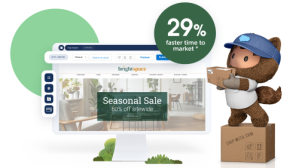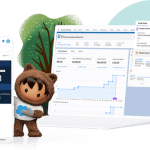The second edition of Salesforce State of Commerce report highlighted the rapid adoption of headless commerce in India as businesses compete to offer enhanced customer experiences. The report, which surveyed 4,102 commerce leaders (5% of whom were from India) and analysed the buying behaviour of over 1 billion B2B and B2C buyers, revealed that:
51% of respondents in India would adopt headless commerce in the next two years



Multiple customer touchpoints, the rise of mobile and social commerce, and rapidly changing trends and consumer behaviours continue to create even more complex buyer journeys. By deploying headless commerce, ecommerce brands can create a personalised, close-to-real-time omnichannel commerce experience.
What is headless commerce?
Headless commerce allows you to easily update the front-end experience on apps and websites based on evolving market trends and incoming data regarding customer preferences. From micro animations and customisations to entire ecommerce platforms- you can build the kind of user experience and interface that you want, and how you want it.
In other words, you can create your own front-end processes and tie these back to pre-packaged backend tasks using an API. For example, in a headless platform, developers can use APIs and tools such as MuleSoft to send blog posts or customer reviews to any screen or device, while front-end teams can present these in any format or framework as per customer preferences to deliver highly engaging experiences.
This makes headless platforms quite flexible and a preferred technology when aiming for agility. They help you save time, effort and cost while unlocking high-performing front-end interfaces. By deploying changes quickly, you can offer relevant, in-the-moment customer experiences across desktops, mobile apps, in-store kiosks, and digital channels.
The advantages of headless commerce
Headless commerce allows you to easily integrate multiple functionalities such as email, mobile devices, shopping carts, online catalogues, personalisation tools, and content management systems (CMS), and thus offer a seamless, consistent customer experience that increases brand loyalty.
Here’s how headless commerce enables you to boost brand loyalty through great customer experiences.
1. Enables increased personalisation
Organisations can make quick changes to their websites or digital storefronts based on seasonality or audience segmentation. You can offer customers a personalised experience (via recommendations, custom purchasing preferences, and promotions) by allowing updates and new content to be quickly displayed across devices and formats. You can also experiment with the look and feel of the presentation layer to reflect customer tastes.
Take the examples of Netflix and Amazon. By using headless commerce, these organisations can offer a customised experience to every user who opens their website or app, without slowing down the speed of performance or reducing the quality of the user experience.

2. Allows quicker adoption of newer digital channels
Consider this: B2C customers interact with businesses through an average of nine different touchpoints. However, every time a company adopts a new channel of communication, it must create brand-new (and seamless) experiences that are in sync with the features of the channel.
With headless commerce, the backend is minimally impacted by the changes you are making to the visual front-end. This means you can just set up the system once and use APIs to deliver standard information (say about inventory and product details) across various channels. This guarantees consistent customer experiences across different channels. Additionally, it also lets businesses quickly make changes to the UI/UX to add (or remove) new digital channels to the ecommerce experience.
74% of respondents in India reported the ability to add new sales channels as a core benefit of headless commerce.



3. Enables better integration between programme components
Headless commerce follows an API-first strategy. This means that businesses can select the right tools, languages and solutions as per requirements and integrate these to build a seamless architecture. This lets you create a best-in-class platform that facilitates seamless data flows between various programme components. Additionally, developers can add new modules or microservices to keep up with demand and technical advancements, without having to update or replace an entire platform.
74% of the respondents agreed that headless commerce improved integration between systems.



Before opting for headless, keep this in mind
While headless commerce makes it easier to offer integrated brand experiences across channels, the decoupling of the front and back end also comes with certain technological challenges. A traditional company which is just embarking on its digital transformation journey should ideally not opt for headless. The business will have to have an extremely skilled in-house IT team which can maintain and sustain headless. Even if you augment the internal team by collaborating with experts, the external party will have to be deeply embedded in your ecosystem for the process to work smoothly.
Additionally, the organisation must be clear about the value-add headless offers to its customers. Any company that feels a consistent experience works well for its customers should go for the template-based approach, which will ensure consistency and lesser complexity.
However, in the absence of the above challenges, headless commerce can indeed revolutionise the customer experience, boosting brand loyalty and ensuring sustainable, efficient business growth in the long run.

























